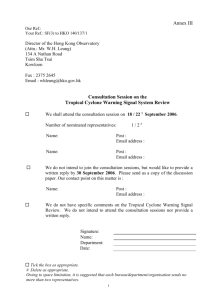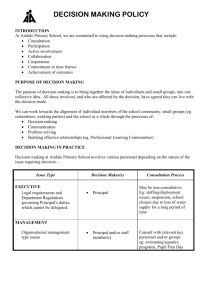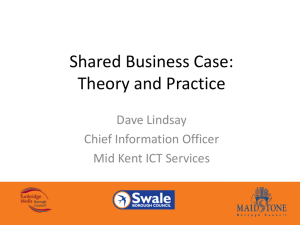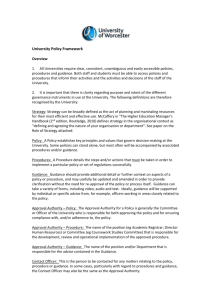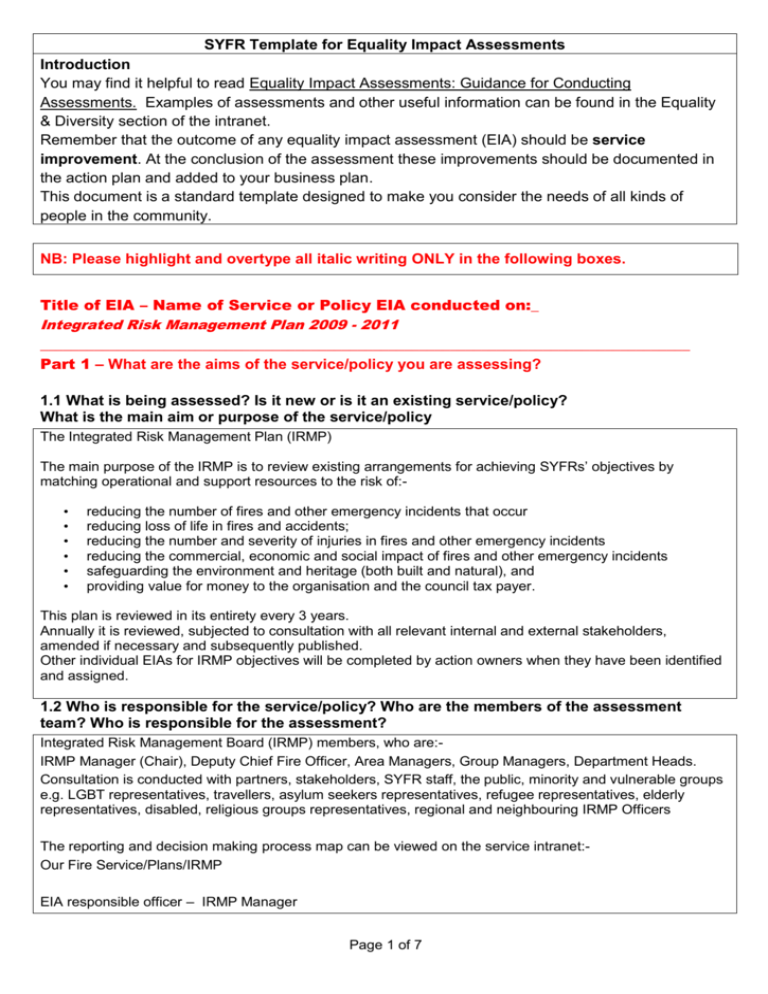
SYFR Template for Equality Impact Assessments
Introduction
You may find it helpful to read Equality Impact Assessments: Guidance for Conducting
Assessments. Examples of assessments and other useful information can be found in the Equality
& Diversity section of the intranet.
Remember that the outcome of any equality impact assessment (EIA) should be service
improvement. At the conclusion of the assessment these improvements should be documented in
the action plan and added to your business plan.
This document is a standard template designed to make you consider the needs of all kinds of
people in the community.
NB: Please highlight and overtype all italic writing ONLY in the following boxes.
Title of EIA – Name of Service or Policy EIA conducted on:_
Integrated Risk Management Plan 2009 - 2011
____________________________________________________________________________________
Part 1 – What are the aims of the service/policy you are assessing?
1.1 What is being assessed? Is it new or is it an existing service/policy?
What is the main aim or purpose of the service/policy
The Integrated Risk Management Plan (IRMP)
The main purpose of the IRMP is to review existing arrangements for achieving SYFRs’ objectives by
matching operational and support resources to the risk of:•
•
•
•
•
•
reducing the number of fires and other emergency incidents that occur
reducing loss of life in fires and accidents;
reducing the number and severity of injuries in fires and other emergency incidents
reducing the commercial, economic and social impact of fires and other emergency incidents
safeguarding the environment and heritage (both built and natural), and
providing value for money to the organisation and the council tax payer.
This plan is reviewed in its entirety every 3 years.
Annually it is reviewed, subjected to consultation with all relevant internal and external stakeholders,
amended if necessary and subsequently published.
Other individual EIAs for IRMP objectives will be completed by action owners when they have been identified
and assigned.
1.2 Who is responsible for the service/policy? Who are the members of the assessment
team? Who is responsible for the assessment?
Integrated Risk Management Board (IRMP) members, who are:IRMP Manager (Chair), Deputy Chief Fire Officer, Area Managers, Group Managers, Department Heads.
Consultation is conducted with partners, stakeholders, SYFR staff, the public, minority and vulnerable groups
e.g. LGBT representatives, travellers, asylum seekers representatives, refugee representatives, elderly
representatives, disabled, religious groups representatives, regional and neighbouring IRMP Officers
The reporting and decision making process map can be viewed on the service intranet:Our Fire Service/Plans/IRMP
EIA responsible officer – IRMP Manager
Page 1 of 7
1.3 Who implements the service/policy? Is the service/policy provided solely by the
team/service/directorate or in conjunction with another team/service/directorate, agency or
contractor? If external agencies are involved, what actions are going to be put in place to
ensure that they comply with the Authority’s Equality and Diversity policies?
Implementation of IRMP service objectives falls to identified staff in designated directorates, sections, project
teams or individuals depending on the objective itself. The action owners are identified by the IRMP Board
(see 1.2 above).
THE IRMP is integral to and cross cuts across all directorates, and works, to ensure that SYFR objectives are
achieved. This is captured in a programme of work by Policy, Programmes and Performance staff and is
monitored by the IRMP Board.
External Contractors – once a proposal is agreed and becomes a project or work stream, external contractors
may be involved dependant on the scope of work, e.g. new fire station builds or vehicle/equipment suppliers.
They will comply with SYFRs’ E&D policies.
1.4 To what extent does the service/policy have an impact on people? Who is affected by the
service/policy and how?
The Consultation Process has a significant impact on people as its primary purpose is to communicate the
contents of the IRMP to as broad a range of people as possible. The IRMP will impact both SYFR staff and
members of the South Yorkshire community by establishing whether prevention, protection, or response
options are appropriate to reduce risk and by implementing those options.
Who is affected and how:
Employees of SYFR – they need to engage in the consultation process
Key stakeholders (partner agencies, local business, local councillors, voluntary organisations) – a
number of representatives from these groups need to engage in the consultation process
The public of South Yorkshire – a selection of people from across the county need to engage in
the consultation process representing all groups across the 6 equality strands
Staff may be affected if identified redeployment of emergency response resource is implemented
and this results in a reduction of establishment, either Wholetime or Retained Duty System staff. It
may have a subsequent effect on recruitment, retention and progression targets.
The communities of each area of South Yorkshire will not be disproportionately affected due to their socio
economic status, race, religion, ethnicity, gender, sexual preference, disability or age and will benefit from a
reduction in risk and increased service delivery performance.
See IRMP actions 2009 – 2011 0n the service intranet.
1.5 How has the service/ policy been promoted or explained to these groups of people?
What analysis has been done to identify if the service/policy is meeting the needs of ALL
these groups of people?
Eight consultation sessions were set up in October 2008:
Stakeholder Consultation
Four stakeholder group sessions held on Council premises between 6-8pm in the evening – generally the
sessions were poorly attended (never exceeding 12 attendees).
A presentation was provided to attendees outlining the purpose of the IRMP and detailing the proposals to be
included in the next plan. Members of the Service then consulted with small groups of attendees, noting
comments, replying to questions and documenting any key concerns. All feedback was then written up and
will be used to determine whether any changes to the plan need to be made.
Although no analysis of the consultees has been undertaken, from a purely visual perspective it was clear that
nearly all were white and aged between 50-65. There was, however a fairly even mix of males and females.
A consultation session was held with Fire Service Cadets aged 13-18, where a range of IRMP questions were
put to them.
Page 2 of 7
There is no evidence of consultation with BME religious groups, those with disabilities, or LGBT groups.
Public Consultation
Four consultation events with members of the public. Again the sessions were poorly attended, but provided
some useful feedback to officers. The same process took place where attendees were given a presentation
on the key elements of the plan and were then consulted with on an individual basis in order to elicit their
views.
Although no analysis was undertaken of the consultees, from a visual perspective it was clear that they were
all white, mainly male and aged 35 to 70.
There is no evidence of consultation with BME religious groups, those with disabilities, or LGBT groups.
A minority group consultation session has been arranged for January 2009 to be attended by a range of
people representing a number of key minority groups – BME, disabled, LGBT etc
SYFR employees are consulted by publishing the IRMP action plan on the SYFR intranet. Feedback will be
received by email to an IRMP mail box.
For staff that do not have access to the intranet, the IRMP action plan has been issued as part of the Weekly
Bulletin – feedback is via telephone or email where possible.
Members of the Fire Authority will have the opportunity to comment on the plan when it is reported to them at
the February Fire Authority meeting and the Equality Scrutiny Board.
Through the consultation process and via staff briefing sessions, focus groups, consultation with young
people, direct mailing to partners/stakeholders and stakeholder meetings, intranet, website, local business
groups, minority groups and by strategically located correspondence e.g. local libraries.
See also EIA for IRMP consultation process and SYFR communications strategy 2009 – 2011. This strategy
is integral to consultation through the Stakeholder Engagement Board.
Part 2 – What data and research do you need to consider?
You need to assess whether certain groups of people may be experiencing a barrier to accessing
your service and /or be disadvantaged by your policy. This section should help you identify the sort
of information that will help you to do this.
2.1 What data, information or results of consultation exercises are available to you to use in
your assessment?
Incident data, prevention and education data, IRMP Board meetings minutes, workshops feedback, feedback
from partner/stakeholder and minority group consultation, feedback from internal consultation, verbally,
written and electronic replies via the website or intranet, national publications, various e.g. FRS Framework
Document, Government (CLG) guidance documents, Community Risk Register.
As stated in section 1.5 the current consultation process has its limitations and has not succeeded in
engaging with a sufficiently broad range of people from across the county.
Statistical information for the county shows the following:
Gender
Male - 51%
Female - 49%
Age
50-64 years old – 17.8%
15-24 years old – 14.4%
Disabled (working age population)
22.5%
BME
Pakistani/Bangladeshi – 2.7%
Page 3 of 7
Indian & Black African – 1.2%
Other Ethnic Group – 2.7%
2.2 What does the information tell you about the value of the service/policy to those intended
to benefit from it? What complaints have been made about the service/policy and have they
been from minority groups of staff/customers?
Section 1.5 clearly shows the limited success of the consultation process. The bulk of those attending the
consultation sessions were white males aged 40-65. The profile detail in section 2.1 shows that South
Yorkshire is quite a diverse community.
Further action is needed to ensure that consultation is undertaken with:
Females
Young People
People with disabilities
People from different ethnic backgrounds
At present, SYFR do not have community profile information on faith and sexual orientation.
There have been no complaints from minority groups of staff or customers/public about this IRMP
2.3 Does the information suggest that this service/policy could have a differential impact on
certain groups of people?
The IRMP outlines the services that SYFR will be delivering over the next 2 years. The consultation process
needs to test whether the plan will have an adverse affect on people representative of the 6 strands of the E &
D strategy (Race, Gender, Sexual Orientation, Religion, and Disability). The limited exposure of the plan to
people from these groups indicates that we cannot say with any certainty that the IRMP will not have a
differential affect on some groups.
Further action is needed to broaden the scope of the consultation.
Part 3 – Assessment of impact
Testing of differential (adverse, neutral or positive) impact of service/policy on groups of
people.
This section asks you to assess the impact of the service/policy in relation to people across the six
strands of diversity covered by the Equality Standard for Local Government and SYFR Equality and
Diversity Scheme, along with any impacts on other groups which may be relevant to our services.
3.1 Using the information available, identify the effects on this service/policy on the following
groups
Note: that you may be able to justify a positive differential impact on grounds of promoting equal
outcomes for under represented or disadvantaged groups within the law
See glossary of terms in guidance to assist you.
(Please tick the appropriate box)
RACE
GENDER
(Men, women,
transsexual people)
Adverse Neutral Positive Explain your answer
Impact
Impact impact
Over 6% of the population of South Yorkshire are of
a race other than ‘White British’. The IRMP
consultation process needs to include BME groups
49% of the population of South Yorkshire is female
yet only a small proportion of the attendees at the
consultation sessions were female. The IRMP
consultation process needs to include more women.
Page 4 of 7
DISABLED PEOPLE
AGE
(Across the whole age
spectrum)
SEXUAL
ORIENTATION
(Heterosexual,
bisexual people.
Lesbians, Gay men)
RELIGION/BELIEF
(and Faith)
OTHER
(Additional groups that
may experience
impacts)
There is insufficient evidence available to state
whether any of the attendees at the consultation
sessions were disabled. Given that 22.5% of the
population of South Yorkshire have a disability,
more needs to be done to consult with them.
Anecdotal evidence shows that the majority of the
consultees were 50-65 years old. Although Fire
Cadets were consulted with on issues relating to the
IRMP, it would be beneficial to consult with a
broader range of people from different age groups.
There is no information available at this stage on
this category
There is no information at this stage on this
category
National and local data will need to have risk
analysis re; housing, poverty and deprivation
issues.
Part 4 – Identifying the changes & improvements you need to make
For any area of adverse impact you will need to consider making changes. If sufficiently
adverse to amount to illegal discrimination you will need to consider the option of
abandoning the policy/service approach causing the adverse impact.
4.1 In Section 3, did you identify any adverse impact? Could it be illegal?
For race, gender, age and disability, it is clear that insufficient consultation opportunities have been
generated and therefore these groups could have concerns about the IRMP proposals but have not
been access to the relevant information.
At present there is no information available on sexual orientation and religion. This information
needs to be made available if practicable.
4.2 How can the barriers be removed or disadvantage minimised? How can you make sure
that this situation is avoided in the future?
The consultation process needs to include representatives from the following groups:
Race
Gender
Age
Disability
Community Profile data needs to be gathered for sexual orientation and religious belief.
Consideration should then given to consulting with these groups on the IRMP
4.3
What equality monitoring, evaluation, review systems will be set up to carry out regular
Page 5 of 7
checks on the effects of the policy/service?
The IRMP will be reviewed and monitored in the following ways:
The IRMP Board meeting will review progress against the actions arising out of this EIA and
the consultation EIA quarterly
The actions from this EIA will also be included in the Policy, Performance & Programmes
Business Plan, where they will monitored on a monthly basis.
Additionally a monthly E & D focus group for the directorate group will review EIAs and
identify new and emerging objectives.
Date
completed
20 Feb 2009
(V2)
Signed by (Manager
conducting the EIA)
Stewart Layhe
Part 5 – Equality impact assessment action plan
Please use this section to develop an Action Plan to implement the key recommendations of the equality
impact assessment:
Please note that this Action Plan should address any concerns or issues related to equality and diversity that
have been identified in the equality impact assessment
This plan should be integrated into your Service/Business Plan.
Recommendations
Undertake an
IRMP consultation
exercise attended
by a range of
stakeholders from
minority groups
Actions Required
Ensure the
stakeholders are
invited to an
appropriate workshop
Timeframe
31/01/09
Resources
required /
Costs
Lead Officer
Corp Comms
to set up the
workshop and
pay expenses
IRMU
Responsible
Manager
Develop a
consultation action
appropriate to the
group and the
timescales allowed
Relevant
Outcome/Performance
Indicator
Feedback on the
2009-11 IRMP from
stakeholders from a
range of minority
groups
Gather feedback
from consultation
Undertake an
IRMP consultation
exercise with a
group of young
people
Identify an
appropriate age
group and number of
young people with
which to consult
31/01/09
and
through
out the
year
IRMU
Manager
Feedback on the
2009-11 IRMP from a
group of young
people
Data/Risk
Manager
Community profile
data on sexual
Design a consultation
package appropriate
to the age group
Gather feedback
from consultation
Collate community
profile information
Research various
statistics websites
31/01/09
and
Page 6 of 7
in relation to
religion and sexual
orientation
and journals
ongoing
Undertake an
IRMP consultation
exercise attended
by a range of
stakeholders from
minority groups
Ensure the
stakeholders are
invited to an
appropriate workshop
orientation and
religious belief
available for use by
all staff completing
EIAs.
Compile a range of
management
information for use by
staff conducting EIAs
Develop a
consultation action
appropriate to the
group and the
timescales allowed
31/01/09
and
through
out the
year
Corp Comms
to set up the
workshop and
pay expenses
IRMU
Manager
Feedback on the
2009-11 IRMP from
stakeholders from a
range of minority
groups
Gather feedback
from consultation
Part 6 – Equality impact assessment summary report
The results of equality impact assessments must be presented to the Fire & Rescue Authority &
published on SYFR website. Please complete this summary, which will be used to report the EIA to
the Fire and Rescue Authority. Please return the completed Equality Impact Assessment to the
Equality & Diversity Manager.
Date of
assessment
Manager’s name
16/12/08 – V2 –
20th Feb 09
Stewart Layhe
Role
IRMU Manager
Service/ policy that was
impact assessed
Integrated Risk Management Plan 2009 - 2011
Summary of findings
recommendations and key
points of action plan
The IRMP consultation process has failed to include a
sufficiently diverse group of people with which to consult.
Further consultation is required.
There is currently insufficient community profile information
available in relation to sexual orientation and religious belief –
further information needs to be gathered and used to help
develop this EIA.
Page 7 of 7




